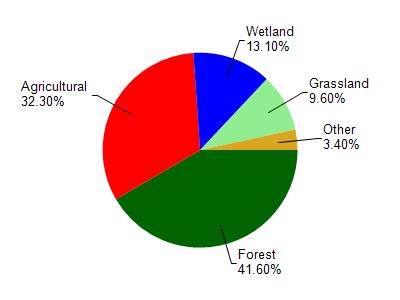Buffalo, Pepin
Yes
No
Yes
Fish and Aquatic Life
Overview
The headwaters of Bear Creek originate near Canton in Buffalo County and flow ovewr 16 and a half miles before dishcarging into the Chippewa River. The middle section of Bear Creek (mile 0.37 - 6.62) is classified as a Class II Trout water. This trout fishery is threatened by streambank grazing, whch causes bank erosion, and cropping to the stream's edge, whlch contributes additional sediment to Bear Creek. Periodic flooding also has an effect on in-stream habitat. The Durand Sportsman Club and the Soil Conservation Service have installed riprap along some banks of Bear Creek and conducted habitat restoration work (Holzer).
Date 1996
Author Aquatic Biologist
Condition
Wisconsin has over 84,000 miles of streams, 15,000 lakes and milllions of acres of wetlands. Assessing the condition of this vast amount of water is challenging. The state's water monitoring program uses a media-based, cross-program approach to analyze water condition. An updated monitoring strategy (2015-2020) is now available. Compliance with Clean Water Act fishable, swimmable standards are located in the Executive Summary of Water Condition in 2018. See also the 'monitoring and projects' tab.
Reports
Recommendations
Water Quality Planning
The Bear Creek Watershed covers 76.5 square miles in Buffalo and Pepin counties. Bear, Little Bear, and Spring creeks are the three primary sub-watersheds within the Bear Creek Watershed. The watershed drains rolling agricultural and wooded areas with many of the tributaries originating in steep coulees. The watershed also drains one urban area, the City of Durand. All streams within the Bear Creek Watershed drain the eastern slope of the Chippewa River Valley. The Bear Creek Watershed contains typical steep topography characteristic of the driftless or un-glaciated area of the state. Because the most productive and level land is on the valley floor, most farming takes place immediately adjacent to streams. Former prairie and a portion of the forested lands have been converted to agricultural uses. The quality of trout streams in this watershed have improved or degraded as agricultural uses have diminished or increased. Earlier editions of the Lower Chippewa River Water Quality Management Plan indicated the Nelson wastewater treatment plant and Nelson Cheese actory discharged to the Lower Chippewa Basin. Due to a basin oundary change, both are in the Buffalo- Trempealeau River Basin. The majority of the wetlands in the watershed are adjacent to the Chippewa and Mississippi Rivers.
Management Goals
Wisconsin's Water Quality Standards provide qualitative and quantitative goals for waters that are protective of Fishable, Swimmable conditions [Learn more]. Waters that do not meet water quality standards are considered impaired and restoration actions are planned and carried out until the water is once again fishable and swimmable
Management goals can include creation or implementation of a Total Maximum Daily Load analysis, a Nine Key Element Plan, or other restoration work, education and outreach and more. If specific recommendations exist for this water, they will be displayed below online.
Monitoring
Monitoring the condition of a river, stream, or lake includes gathering physical, chemical, biological, and habitat data. Comprehensive studies often gather all these parameters in great detail, while lighter assessment events will involve sampling physical, chemical and biological data such as macroinvertebrates. Aquatic macroinvertebrates and fish communities integrate watershed or catchment condition, providing great insight into overall ecosystem health. Chemical and habitat parameters tell researchers more about human induced problems including contaminated runoff, point source dischargers, or habitat issues that foster or limit the potential of aquatic communities to thrive in a given area. Wisconsin's Water Monitoring Strategy was recenty updated.
Grants and Management Projects
Monitoring Projects
| WBIC | Official Waterbody Name | Station ID | Station Name | Earliest Fieldwork Date | Latest Fieldwork Date | View Station | View Data |
|---|
| 2061900 | Bear Creek | 10031766 | Bear Creek- Station 4F ~ 240m downstream of CTH B | | | Map | Data |
| 2061900 | Bear Creek | 473017 | Bear Creek at Cth B | 4/14/1998 | 10/27/2025 | Map | Data |
| 2061900 | Bear Creek | 10031692 | Bear Cr- Station 4C- at confluence with Newton Valley Cr- Ward property | 6/23/2011 | 1/1/2015 | Map | Data |
| 2061900 | Bear Creek | 10055912 | Bear Creek County Highway A at county line | | | Map | Data |
| 2061900 | Bear Creek | 10008592 | Bear Creek- 18m US of CTH B (station 5) | 6/23/2011 | 8/22/2023 | Map | Data |
|

Watershed Characteristics
Bear Creek is located in the Bear Creek watershed which is 176.55 mi². Land use in the watershed is primarily forest (41.60%), agricultural (32.30%) and a mix of wetland (13.10%) and other uses (13.00%). This watershed has 383.21 stream miles, 1,080.51 lake acres and 16,135.70 wetland acres.
Nonpoint Source Characteristics
This watershed is ranked Low for runoff impacts on streams, Not Ranked for runoff impacts on lakes and High for runoff impacts on groundwater and therefore has an overall rank of High. This value can be used in ranking the watershed or individual waterbodies for grant funding under state and county programs.However, all waters are affected by diffuse pollutant sources regardless of initial water quality. Applications for specific runoff projects under state or county grant programs may be pursued. For more information, go to surface water program grants.